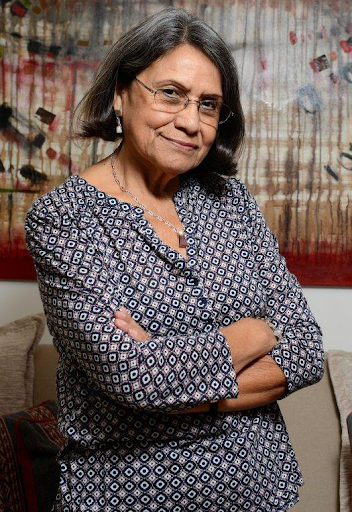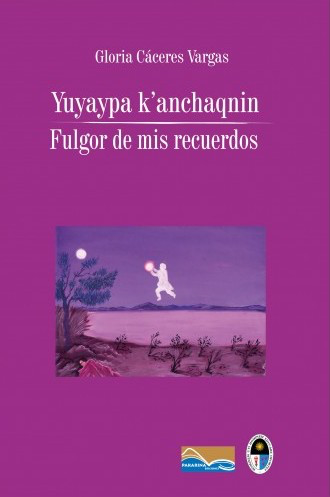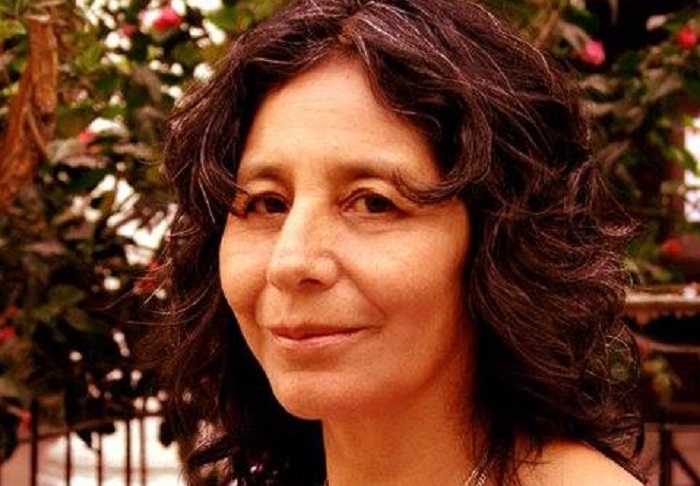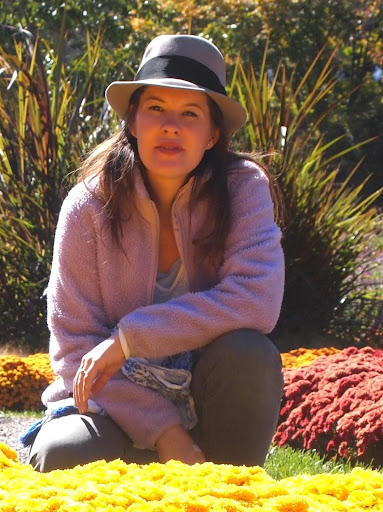From Musqu Awaqlla (2021), and Yuyaipa k’anchaqnin (2015) © Gloria Cáceres Vargas
Selection, and translation from Quechua © Fredy Amílcar Roncalla
If you prefer to read this as a PDF, click HERE
Gloria Cáceres Vargas is an Andean educator, narrator and poet. In Peru, she has worked as consultant for the Intercultural and Bilingual Education Office of the Ministery of Education, and as Dean of the Social Sciences and Humanities at Enrique Guzmán y Valle National University of Education. In Paris–France, she has offered Quechua courses at the National Institute of Languages and Civilizations (INALCO); as well as Spanish and Latin American civilization courses at the University of Paris 3 Nouvelle Sorbonne, and the University of Cergy-Pontoise. She has published Reqsinakusun (1996), Munakuwaptiykiqa (2009), Wiñay susqayki (2010), Yuyaypa k’anchaqnin / Fulgor de mis memorias (2015), and Musqu Awaqlla / Tejedora de Sueños (2021). She translated into Quechua Warma Kuyay and other stories (2011) by José María Arquedas. The following poems from her last two books were selected and translated from Quechua to English by Fredy Amílcar Roncalla. The eroticism of this poetry–attentive to the voices of the wind, the rain and the sacred mountains, Apus–empowers the voice and body of Andean women, and the richness of the Quechua language to sing them.
Puquy mitapa saqaqay rapinkuna
Puquy mitapa saqaqay rapinkuna
Vivaldipa musikanman
challpuykuwan.
Hanaq pachapa waqaynin chay puquy mitapi
maypi urmasqa rapikuna
llimpisqa pampata awanku
yupiyta chaskinanpaq.
Violinkunapa tunadanwan
sunquypa patpatninkunawanpas qispirimuni
kuskasqa chakiywan tusunaypaq
chay llimpillasqa pampapi.
Sallqa sunquytaq
kuyakuyta munapayaspa
qiwiykachakun.
Hatunkaray tunada
puriykunata huk kitiman
pusaykun.
Chaypim arpapa violinpa
miski waqaynin
llaqtaypa uchuk paqchanpa
musikanwan musquchiwan.
Aysachakuq musikam,
Vivaldipa wata mit’ankunawan
yuyayniykiwanpas
musquchiwan,
karumanta hamuspa
ama waqaspalla, niñachay
sunquyta ninku.
Huk puquy mitapa rapinkuna, mawk’ayaspaña
wayrawan maymantachá hamunku.
Fall sounds
Gentle sounds of autumn
fill me with
Vivaldi’s music.
Falling leaves of celestial sounds
weave a colorful tapestry
for my steps.
This realm of color
is where my feet dance happily
following violin melodies
and my wild heart
yearns for love beat
by beat.
This great song
brings my path to realms
where sweet harp and violin notes1
remind me the sounds
of my town’s small waterfall.
That uplifting music
makes me dream about Vivaldi’s stations
while your distant memory
comes around and says
Don’t cry no more, dear.
Suddenly aged
the autumn leaves
travel with winds
from unknown places.
1 Most indigenous traditional music in Peru is played with harp and violin. It is also said that musicians learn their melodies in sacred waterfalls (translator’s note.)
Parapa sunqun tapsikun
Parapa sunqun tapsikun
chillikukuna mana usyaq
llakinta takiptinku.
Parapa sunqun llakikun
pisqukuna qasikayta maskaspa
ripuptinku.
Parapa sunqun upallakun
timpupa marqankuna
mana llakikuspa muyuykachaptinku.
Parapa sunqun kusikun
killa hunt’api mana samaspa
tusuptinchik.
Ñuqataq, parapa sunqun kayta munani
qamwan musqukunaypaq.
The rain’s heart trembles
The rain’s heart trembles
when the crickets
sing their infinite despair.
The rain’s heart is saddened
when the birds leave
looking for peace.
The rain’s heart becomes silent
when the arms of time
turn around over and over.
The rain’s heart gets happy
when we dance under
the full moon.
And I want to be the rain’s heart
to dream about you.
Parapa llimpin
¿Ima llimpiyuqmi para qaraykiman chayaptin?
¿Ima llimpiyuqtaq ñuqapa qarayman chayakuptin?
¿Ima llimpiyuqtaq llimpikuna kachachaykunapas,
pukllaysapa kuyakuyninchik tinkuptinku?
Huk kutikunaqa parapas ninapas kanchik,
hukkunataq qawapayaq mancharisqa phuyukuna.
¿Ima llimpiyuqtaq pacha, para wayllukuptin
kuskachakuq kusikuynin tusuchiptin?
¿Ima llimpiyuqtaq mayu llapanta aytiptin
para mana riqsisqanman ayqikuptin?
Huk kutikuna wayrapi puqpu kani,
hukkunataq llimpipa llipipiqnin.
¿Ima llimpiyuqmi qiwa chaskiwaptinchik,
maypi kuyakuyninchik maytukuyta maskaptin?
¿Ima llimpiyuqtaq manchakuyniy munakuyniypas
kawsaypa k’anchaqnin wañukuchkaptin?
Huk kutikuna hanaq pacha uqhusqa ch’imsikunawan
rupayniykunata qasillachin.
Rainfall colors
What is the color of the rain when it reaches your skin?
And what color is it when it reaches mine?
What is the tonality when our sparks and color
get mixed in our playful loving encounters?
Sometimes we are rain and fire,
and some others shy clouds afar.
What is earth’s color and the loving rain
when they dance their encounter happily?
What is the color of the river that cleans everything
after the rain leaves to unknown places?
Sometimes I am an air bubble,
and some others a spark of color.
What is the color of the foliage that welcomes us
when our passion seeks shelter?
What is the color of my fears and tribulations
when the light of life fades away?
Sometimes the universe calms my fire
with subtle humid gestures.
Now the rain has arrived dressed in light
illuminating my solid shadow
and bringing the messages of the Apus.2
Infinite rain of color!
Your heart is the color of the one who loves you,
generous and beloved rain.
2 Apu refers to the local gods, mostly guardian mountains (translator’s note.)
¿Pitaq kani?
k’anchaptin llantuyta maskakuni
qawarikuspa k’atatani
ch’in niqpi sunquykita
uyarini.
Intipa sunkanpi
musquyniy k’añakun.
Hanaq pachapa llimpi uchpakuna
tuta cayanankama mayt’uykuwan.
Urqukunapa kallpan
mana llakikuspa saqiwan.
kachiyuq wiqiywan
chinkaq yupiykunata aytini.
Mana usyaq kusikuywan
tusustin suyayki.
Yachankiñachu kunan
¿pitaq kani?
Who am I?
I look for my shadow when the light shines,
and tremble seeing myself.
I hear your heart
silently.
My dreams burn
in the sun.
Colorful ashes in the sky
cover me until nightfall.
The power of the mountains
depart mercilessly.
I rinse my lost steps
with salty tears.
I am waiting for you with a dance of infinite joy.
Now, do you know who I am?
Muskakuptiyki
Muskakuptiyki
mayuqa karunchakuspa
qasilla tukuq
sunquykihina.
Ichaqa chayqa
maqanakuyllam,
munakusqaykipi
munakusqaywan.
Mana imanaykiqa
manañam tapsiwanchu.
Chayqa chipayllam
mallkuchiwanaykipaq.
When I look for you
When I look for you
the distant river becomes quiet
just like your heart.
That is just
a contest
between you
and my desire.
Your indifference
no longer bothers me.
It’s just a trick
to make me want you.
¿Chaypiraqchu kachkanki?
Sichus takyi manaña
iñiq sunquykita takinchu,
¡imanasaqma!
Qamqa, huk wayllukunawan.
Ñuqataq, kaypi, qunqayniykiwan…
Mayuhinam kawsay
richkan patpatyastin
sapa muyuriyninpi
K’iriykunata hamp’istin.
¿Chaypiraqchu kachkanki?
Manañam uyariykichu.
¿Ichapas pasapuniña
huk tiqsi-pachaqunaman?
Are you still there?
If my voice no longer
sings to your heart,
What am I to do?
You have other loves
And me, here, forgotten.
My life flows
like a river
trembling in each meander
and healing my wounds.
Are you still there?
I no longer hear you.
Perhaps I have departed
to other realms.
Kaypiraqmi Kachkani
Kaypiraqmi kachkani
Apukunata suyastin.
Karumantam hamuchkanku
sayk’usqa, maqanakusqnmanta.
Takanakusqakum
musqunchikrayku
wawanchikrayku
qichusqa yuyayninchikrayku.
Ichapas nimuwanman
takiy kallpachasqankuta
ichapas munachiwanman
kuyakuq puka rosas waytata.
Tiqsimuyu patanpi
wiñay unanchayninta suyani.
¡Kusikuyllam!
I am still here
I am still here
waiting for the Gods.
They are coming from afar
tired of fighting each other.
They fought
for our dreams
our children
and our dispossessed memory.
Maybe they can tell
if my singing makes them stronger.
Maybe they could make me want
a loving red rose flower.
At the outer limits of the world
I wait for their eternal mandate.
Happily!
For more about Gloria Cáceres Vargas
- Gloria Cáceres in the Musuqilla Project
- “Warmipa qapariynin / Cries of a Woman”, in Latin American Literature Today.
The translator

Fredy A. Roncalla was born in Chalhuanca, Apurimac, Peru in 1953. He has studied linguistics and literature, in addition to a long journey in Andean Studies, with a special focus on aesthetic elements. He is also a handcraft artist who works with recycled materials. He has published poetry and essays in diverse online and printed publications. He is the author of Canto de pájaro o invocación a la palabra (Buffon Press, 1984); Escritos Mitimaes: hacia una poética andina postmoderna (Barro Editorial Press, 1998); Hawansuyo Ukun words (Hawansuyo/Pakarina Ediciones, 2015); and Revelación en la senda del manzanar: Homenaje a Juan Ramírez Ruiz (Hawansuyo/ Pakarina, 2016). He is currently working on Llapan llaqtan: narrativa y poesía trilingüe/ Llapan llaqtan: trilingual poetry. His trans-Andean projects can be foundin the virtual ayllu: Hawansuyo Peruvian Bookstore, Churoncalla.com, y Hawansuyo.blogspot.com
From Musqu Awaqlla (2021), and Yuyaipa k’anchaqnin (2015) © Gloria Cáceres Vargas
Selection, and translation from Quechua © Fredy Amílcar Roncalla ~
Siwar Mayu, January 2024





